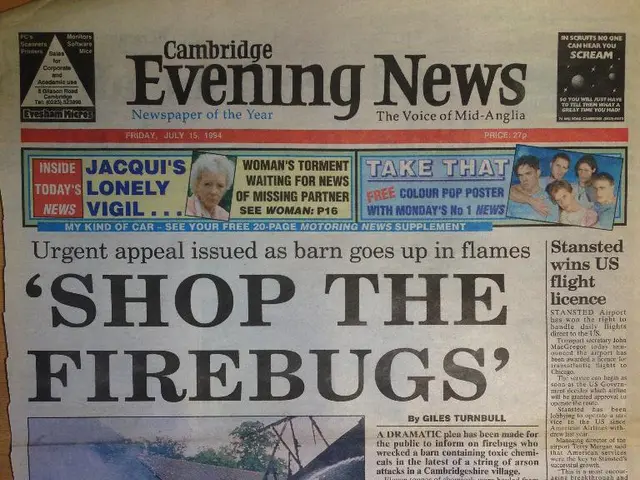Nine Species Capable of Sexual Transformation to Ensure Survival
Dive into the wild and wondrous world where change is the only constant – a world where some critters 'switch it up' for their survival! This eccentric adaptation, known as sequential hermaphroditism, is far from a mere evolutionary gimmick. It's a strategic maneuver to extend their lives and thrive amidst environmental turmoil. Without further ado, let's explore the captivating lives of these versatile organisms.
Clownfish: Masters of the Seaside Circus
Owing to a certain Pixar flick, clownfish are well-known for their ability to adapt. In a sea of colors, these vibrant fish reign supreme with their extraordinary abilities. They dwell in social structures, with the dominant female ruling the roost. If she sadly pops her clown fin, the dominant male will transform into a female, maintaining the fantastic fusion of reproduction and reign! This remarkable adaptation is not confined solely to physical changes but extends to behavioral shifts, emphasizing the adaptability and survival instincts of these saltwater companions.
Wrasses: Swimming Chameleons
These colorful inhabitants of coral reefs are another prime example of transcendental chameleons. Born females, these transformers begin their journey as males as they mature. This transition is typically guided by social cues like the absence of a dominant male. By adopting a new identity, wrasses manage a balanced population, thereby maximizing breeding success. Such incredible metamorphosis involves more than a makeover – it expands to alter their coloration and behavior, making them well-suited to thrive in coral reefs that host multiple intrigues and competitions.
Parrotfish: Reef Guardians Extraordinaire
A crucial part of the health of coral reefs, parrotfish dazzle us not just with their vibrant hues but also their inspiring ability to adapt. They usually make their debut as females but may transform into males as they age. This change speeds up by the need to fill specific roles in their social structure, ensuring a balanced population that can reproduce effectively. Their striking beauty and unique antics make them a favorite among deep-sea admirers, serving as a testament to evolution's magic.
Gobies: Tiny Shapeshifters
Although small, these diminutive dwellers of the deep seas are anything but insignificant when it comes to switching sides. Typically living in pairs, one of them assumes the dominant role. If the dominant one bites the dust, the lucky survivor can morph into a dominant figure, keeping the reproduction engine running. This extraordinary flexibility allows gobias to swiftly adapt to their environment, contributing to their resilience and versatility within marine ecosystems.
Oysters: Flexible Oceanic Romancers
Known for their edibility and pearls, oysters are not just stunning mollusks. They exhibit the remarkable ability to change sex in response to various factors. Such transformations occur depending on environmental conditions or population dynamics, enhancing their reproductive success in even the harshest conditions. Adapting to their surroundings, oysters demonstrate the amazing adaptability and resilience of these intriguing creatures.
Grouper: Giants with Chameleon-Like Characteristics
Groupers are titans of the deep seas, but their ability to adapt to new identities is equally impressive. Born females, these mighty swimmers may transform into males as they grow, generally to offset the shortage of dominant males. By donning different masks, groupers manage a balanced population, thereby ensuring productive reproduction across diverse marine habitats.
Moray Eels: Agile Shape-Shifters
As sinuous as they are mysterious, moray eels boast an impressive metamorphosis ability. They can flip-flop from male to female or vice versa in response to social or environmental cues. This miraculous alteration aids in maintaining balanced sex ratios within populations, emphasizing their adaptability and survival instincts in varied marine ecosystems.
Cardinalfish: Surprising Switchmasters
Known for their nocturnal habits and flashy colors, cardinalfish quench curiosity not only through their mystery but also their power to transform. Similar to gobias, they typically thrive in pairs, with one assuming the mantle of dominance. Upon losing the sexy battle, the defeated one becomes the victor, exchanging roles to uphold reproduction. This remarkable capacity to transform swiftly makes cardinalfish invaluable players in the ocean's symphony of life.
Coral-Reef Damselfish: Dynamic Disguisers
Coral-reef damselfish are small and fierce, but their ability to blend chameleon-style is equally impressive. Typically dwelling in social groups, they are led by a dominant male. In the wake of the leader's demise, a female may take up the role, thus ensuring the group's continuation and reproductive success. Through their adaptability, coral-reef damselfish continue captivating divers with their vivacious aura, shedding light on the unparalleled adaptability in the oceanic kingdom.
In conclusion, the art of transformation lies in the heart of various species as they navigate through their unique oceanic journeys. From the vibrant corridors of coral reefs to the wide-open seas, the pattern of adaptation is evident. Adjusting to their surroundings, these captivating organisms defy traditional gender roles, showcasing the intricate dance of life in the natural world.
- In the world of health-and-wellness and fitness-and-exercise, the captivating lives of sequential hermaphroditic creatures, such as clownfish and gobies, offer valuable lessons on adaptability and survival.
- The science behind these organisms' evolutionary transformation demonstrates the symbiotic relationship between evolution and the health-and-wellness of ecosystems, especially within marine habitats.
- Sexual-health studies on the various adaptive strategies employed by species like wrasses, parrotfish, moray eels, cardinalfish, and coral-reef damselfish could potentially inspire innovative solutions in human health and wellness, highlighting the interconnectedness of life on Earth.








